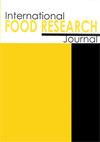茶多酚与鼠李糖乳杆菌 R5 结合使用可改善肥胖症,并改变高脂饮食小鼠的肠道微生物群组成
IF 0.7
4区 农林科学
Q4 FOOD SCIENCE & TECHNOLOGY
引用次数: 0
摘要
茶多酚(TP)和鼠李糖乳杆菌都被证明可以减轻肥胖,调节脂质代谢。然而,它们的综合作用及其潜在的作用机制仍然难以捉摸。本研究比较了 TP、鼠李糖乳杆菌 R5(R5)和 TP+R5 对高脂饮食喂养小鼠血脂和肠道微生物群的影响。结果表明,TP 和 R5 的组合能有效提高高脂饮食小鼠的血清高密度脂蛋白胆固醇(HDL-C)水平,降低总胆固醇(TC)水平、低密度脂蛋白胆固醇(LDL-C)水平和动脉粥样硬化指数(AI)。联合疗法改变了小鼠肠道微生物群的结构,具体表现为F/B比值降低,有益菌属(如Akkermansia muciniphila、Faecalibaculum rodentium和Ruminococcus_uncultured bacterium)数量增加。此外,粪便中的 SCFAs(乙酸、丙酸和丁酸)含量也有所增加。这些都为抗肥胖方法提供了新思路,也为开发益生菌与茶多酚相结合的食品提供了理论依据。本文章由计算机程序翻译,如有差异,请以英文原文为准。
Tea polyphenols combined with Lactobacillus rhamnosus R5 ameliorate obesity, and alter gut microbiota composition in high-fat-diet-fed mice
Both tea polyphenols (TP) and Lactobacillus rhamnosus have been shown to alleviate obesity, and regulate lipid metabolism. However, the combined effects and their underlying mechanisms of action remain elusive. In the present work, the effects of TP, Lactobacillus rhamnosus R5 (R5), and TP+R5 on blood lipids and the gut microbiota of mice fed with a high-fat diet were compared. Results showed that the combination of TP and R5 effectively increased the serum levels of high-density lipoprotein cholesterol (HDL-C), and decreased total cholesterol (TC) levels, low-density lipoprotein cholesterol (LDL-C) levels, and the atherosclerosis index (AI) in mice fed with a high-fat diet. The combination treatment resulted in a modification of the structure of the gut microbiota in mice, as evidenced by a decrease in the F/B ratio, and an increase in the abundance of beneficial genera, such as Akkermansia muciniphila, Faecalibaculum rodentium, and Ruminococcus_uncultured bacterium. Additionally, the contents of SCFAs (acetic, propionic, and butyric acids) in faeces also increased. These could provide new ideas for anti-obesity methods, and a theoretical basis for the development of foods combining probiotics and tea polyphenols.
求助全文
通过发布文献求助,成功后即可免费获取论文全文。
去求助
来源期刊

international food research journal
Agricultural and Biological Sciences-Food Science
CiteScore
1.40
自引率
0.00%
发文量
75
期刊介绍:
The International Food Research Journal (IFRJ) publishes papers in English, six (6) issues a year with the coverage of:
Food Science and Technology
Nutrition and Dietetics
Agriculture, multidisciplinary
Chemistry, multidisciplinary
The scope of the Journal includes:
Food Science, Food Technology and Food Biotechnology
Product Development and Sensory Evaluation
Food Habits, Nutrition, and Health
Food Safety and Quality
Food Chemistry, Food Microbiology, Food Analysis and Testing
Food Engineering
Food Packaging
Food Waste Management
Food Entrepreneur
Food Regulatory
Post-Harvest Food Management
Food Supply Chain Management
Halal Food and Management
 求助内容:
求助内容: 应助结果提醒方式:
应助结果提醒方式:


